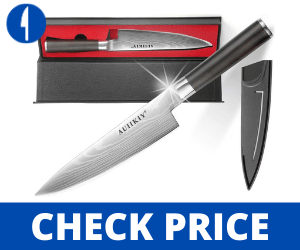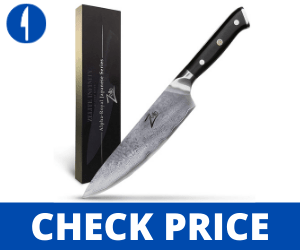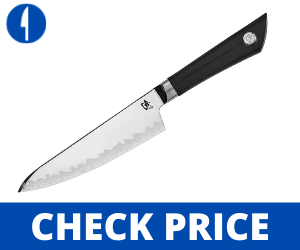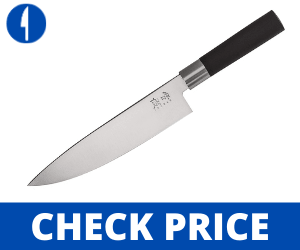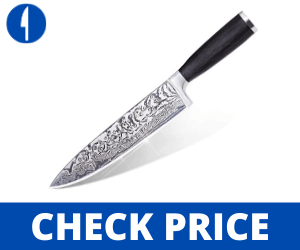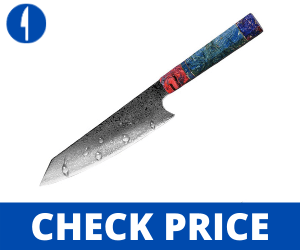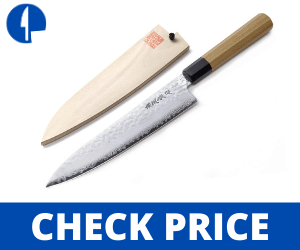Japanese Knives are preferably the best choice of professionals as they are super sharp, easy to use & maintain. Best Japanese Chef Knives usually use a thick spine with a thin cutting edge, which helps a lot in cutting the dense meats & vegetables.
In the western world, Japanese Gyuto are the closest rival of Wustuf as these Gyuto’s are considered as an All-Rounder knife. If you are looking to enhance your productivity, you need to get some best Japanese Chef Knives.
Here comes our part to let you help in making a selection for some best Japanese Gyuto. Without taking your further time, let’s break the pack here!
Top 3 Picks of Best Japanese Chef Knives

- Material: Stainless Steel
- Size: 12 inches
- Weight: 11.2 ounces
- Dimensions: 14.75 x 1 x 3 inches
- Manufacturer: J.A. Henckels
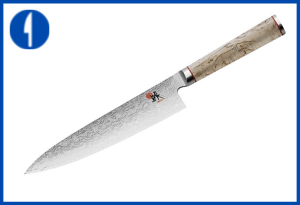
- Material: Alloy Steel
- Size: 8 inches
- Weight: 19.2 ounces
- Dimensions: 3.31 x 1.38 x 15.13 inches
- Manufacturer: Miyabi
Quick glance on knives for Chefs
| IMAGE | PRODUCT | SHOP |
|---|---|---|
|
Overall Best

|
Miyabi Kaizen Chef’s Knife
|
Shop Here |
|
Best Lightweight
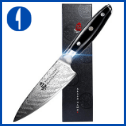
|
TUO HAWK S-Series Chef Knife – 6-inch Pro
|
Shop Here |
|
Durable
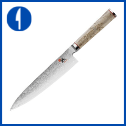
|
Miyabi Chef’s Knife, 8-Inch, Birch/Stainless Steel
|
Shop Here |
|
Best Yoshihiro

|
Yoshihiro VG-10 Gyuto Japanese Chefs Knife
|
Shop Here |
|
Best Budget

|
Tojiro DP Gyutou – 8.2″
|
Shop Here |
|
Best Comfortable

|
Shun Sora 6 Inch Chef’s Knife
|
Shop Here |
|
Edge Retention

|
Kai Wasabi Black Chef’s Knife, 8-Inch
|
Shop Here |
|
Best Common Use

|
Promithi Chef Knife 8 Inch Kitchen Kiritsuke Knife
|
Shop Here |
|
Easy to sharpen

|
Miyabi Fusion Morimoto Edition Wide
|
Shop Here |
Best Japanese Chef Knives | Our Best Picks & Review
1. Miyabi Kaizen Chef’s Knife
Let’s get started with Miyabi’s Gyuto, which you may (or may not) know if your colleagues are using it. Miyabi is a knife brand that doesn’t need any praise. Their quality is what made us put their knife on top of the list, just like a cherry on a cake.
Build Quality & Material:
Technically, it has a Rockwell hardness scale of 60 HRC, which defines its ability itself. But yes, these things may slightly differ from unit to unit with a little variation. It has a cutting edge, which turns at a 10-degree average edge, to make it some better retention.
On a lighter but effective note, you will find 03 multiple Miyabi chef knives on the list. So, let’s get back to Miyabi’s Kaizen which should be the workhorse of your hotel’s kitchen.
Cutting & Performance:
For the price, it is one of Miyabi’s entry-level performers, but don’t judge the book with its cover, as it has a decent performing blade out of the box. This does perform pretty awesome as compared to some of the other quality Japanese knives on the list.
Miyabi is offering this guy in two different blades i.e, 6-inches & 8-inches. Both of these blades are versatile & competent at their physiques & curb weight. This has a flourishing stainless steel material, which is using some sort of ice-hardening manufacturing to ensure its stability & durability.
Just like other Miyabi, the Kaizen is also a handmade tool, which is a dream of every traditional chef. You will barely locate any manufacturing defect in the body, which gives a clear idea of Japanese Craftsmanship. There are no sharp edges, nor fluffy coverings, which sometimes results in affecting productivity.
Best for cutting:
Vegetables, Steak, non-citrus fruits, Semi Cooked Beef, butternut squash, raw beets, watermelon, & salad ingredients.
Pros
- D-shape end Micarta handle
- Versatile & pre sharpen blade
- True Traditional craftsmanship
- Honbazuke honing at 12° edge
- Stainless steel durable blade
Cons
- Not recommended for bigger hands
2. TUO HAWK S-Series Chef Knife – 6-inch Pro
How does the Best Seller sound to you? Doesn’t it fascinate? Of Course it does.
This Gyuto AKA Chef knife is the best Japanese chef knife due to so many reasons, which we are going to explore.
Build Quality & Material:
HAWK series is delivering the best edge retention, nice stability, more than average sharpness, durable & versatile blade along with 56 HRC of Rockwell hardness.
Though the edge is retained, it does not seem to be long lasting in busy hands. Yet, we do recommend strongly for Amatuer chefs or assisting tasks. It is a good choice for gifting, as it has an attractive full tang G 10 handle & water flow pattern.
Cutting & Performance:
The best possible reason for this honor is it’s surprisingly lower price, which is hard to see for these knives. But here’s the best reason, which we found personally. It is the most flexible & convenient chef knife, which is actively welcomed by every single chef.
If you are an amateur chef, you can also use it without any need for special practice & training to handle it. First of all, This is not a big knife that tends to unbalance. Second, it has a comfortable handle of the same length as its blade, which significantly improves its productivity.
Although there are a lot of variants with many different sizes roaming in this particular knife, we found the 6-inches variant the best one both due to its pricing, performance & handling.
Best for cutting:
Vegetables, Steak, non-citrus fruits, Semi Cooked Beef, slicing, dicing & dairy products.
Pros
- Mosaic riveted G-10 handle
- V-Nitrogen tempered blade
- 8-12° angle & sharpen razor
- German Stainless steel blade
- A Lightweight chef knife
Cons
- A slippery handle
3. Tojiro DP Gyutou – 8.2″
Tojiro making a debut on the list with its successful DP Gyuto which is waiting for you to serve in your kitchen. A brief intro about Tojiro; this is a slightly newer brand as compared to some others. But this still has a history of more than 6 & a half decades in the field.
Build Quality & Material:
Getting back to their Gyuto, this has a blade of stainless steel, but this is not the true stainless steel as it is not possible for this price. The knife is double bevel, which makes it handy for both left & right-handed chefs.
Cutting & Performance:
Tojiro’s blade doesn’t have any Tushime or water pattern on its face, which makes it a completely plain knife, also known as Western-style knives. It has a brushed finish on it, which somehow prevents slips or friction while cutting the ingredients.
It is a little bit rear heavy knife due to its bolster in the back. Next to its blade, it has a laminated plastic sheet, which prevents the handle from soaking the water. However, the knife is still balanced effectively.
Overall, the knife is using a straight profile, which has an edge over the round profile knives, especially if you want to prepare far east or Japanese cuisine such as Sushi or Thai food.
Best for cutting:
Cheese, Butter, Bread, Buns, Baking Products, Vegetables, Fruits, Steak & Semi-Cooked meat.
Pros
- Affordable yet sharper knife
- A Full tang wooden handle
- Safe Laminated plastic handle
- No sharp edges on the blade
- Impressive cutting performance
Cons
- Needs frequent sharpening
4. Professional Chef Knife 7 Inch
You want something good but at a cheap price & haven’t found it yet? Don’t worry, we are now heading you towards a cheap Japanese chef knife from Here.
Build Quality & Material:
Though this is a high carbon steel knife, there’s some chance of rusting, if you would not take care of it properly. For every high carbon steel knife, you should use hand wash & dry it immediately right at the spot. Otherwise, your knife will start getting dull.
Cutting & Performance:
Now, this is not the super true Japanese knife, but it does have similarities & the same performance. So, if you were hoping for some genuine stuff, stop scrolling right now & check out the Tojiro’s Gyuto we just talked about.
For those who want to proceed; let’s open the box!
This chef knife is a multifunction knife, which you can use for various tasks. From slicing & chopping to breaking eggs, making bread & sushi. The knife does perform better in terms of sharpening, but you will be sharpening it every single day.
A good thing is its design & handling. This is using a comfortable yet practical handle, which does not let you tired. You can have long sessions with this knife. Overall, the knife is well balanced & lightweight, which also comes along with a laminated sheath.
Best for cutting:
Pizza, lasagna, dinner making, Steak, Ribs, Fat trimming, bread, cheese & veggies.
Pros
- Best for general chef tasks
- A beautiful chef gift choice
- Sharp & balance knife blade
- Cheapest Japanese chef knife
- Versatile & comfortable grip
Cons
- Not a good pick for professional chefs
5. Zelite Infinity Chef Knife 8 Inch, Japanese AUS-10 Stainless Steel
Zelite for the only time on Best Chef’s Knives list, with its stainless steel chef knife.
Build Quality & Material:
This lightweight chef knife features a Japanese stainless steel blade core, that is named AUS-10 steel. The knife comes in a couple of variants just in its Chef knife blade, which holds up to 03 different blade sizes out of the box.
Zelite Infinity Chef’s knife is using flagship layered construction steel, that is obtained through completely traditional & manual forging from professional hands. This has made the blade’s micro-structure completely foolproof.
The knife holds a relatively medium-thick blade that is almost 2.5mm thick. Now, this is not going to deliver you ultra-fine & exceptionally deep cuts. However, it is capable enough to strongly resist the sudden impacts in case of single strokes.
Cutting & Performance:
Zelite has completed its part to make a sharp, & versatile knife out of the box. This blade owns an exceptional level of sharpness, that you can use with raw meats as well. There are a lot of factors contributing to its sharpness.
This knife comes with a double bevel blade, that takes your cutting experience to a completely next level. With this boy, you will also get a decent edge retention, that keeps maintaining its edge pretty much.
Its slightly beveled, & completely contoured blade profile makes the rocking motion pretty smooth, which allows you responsive cuttings. This edge becomes one single point, that you can use to take deep & complex cuts inside a chicken.
Just to bring comfort, along with the versatility to use it for a long time, this knife comes with a well-balanced & full-tang handle that doesn’t let you lose stability. Its G-10 wooden handle makes a strong impression with its durable bolster plate, which features a D-shaped & riveted handle along with it.
Best for cutting:
Raw Meat, Cooked, & Semi-Cooked steaks, Chicken, Fish, Sushi, Veggies, Fruits, Herbs, bakery products, & dairy items as well.
Pros
- Extensively sharp blade
- Resists corrosion & chipping
- A Well-Balanced blade knife
- The Full-Tang handle
- A Good edge retention
Cons
- Sheath is necessary (but not included)
6. Chef Knife FANTECK Professional Damascus
Another affordable & budget Japanese Chef knife from Fanteck’s store, which hardly costs 70 bucks. This is an 8-inches long blade knife which is known as the Damascus steel knife.
But don’t fall into this trap as there’s no such thing that exists for this price. You can either call it deceiving marketing, or an accident. So we have made it crystal clear for you.
Build Quality & Material:
This is a high carbon forged steel knife of layered sheets of steel to form its blade. It is a double bevel knife, which makes it usable for both right & left-handed chefs. For its blade, it has a bevel of 12° on each side, so you have a decent room for sharpening.
Cutting & Performance:
Fanteck’s Gyuto holds a comfortable & lightweight handle that is full tang, making the blade versatile & unbreakable from any joint. Just like any other traditional Japanese knife, it is also using a complete & good looking Tsuchime pattern.
Moreover, this Fanteck’s knife also comes with a mini sharpener along with a sheath out of the box. Besides this, the blade is versatile, sharp & durable at the same time. It is using Nitrogen treatment, which helps in increasing its overall life. This also results in increasing the Rockwell hardness scale.
Best for cutting:
Mincing, slicing & Dicing of Vegetables, Fruits, Meat, Dry Fruits, leaves & Salad.
Pros
- Heat-treated Nitrogen HC steel
- Anti Rust & stain knife blade
- A Sharpener & sheath included
- Durable yet balanced knife
- A Budget Chef Knife
Cons
- Not a true Damascus steel blade
7. Shun Cutlery Kanso 8-Inch Stainless
Shun has now entered our list of best Japanese Chef knives, with its Kanso knife. This is a masterpiece of AUS 10 steel, which is the best for its sharpness, versatility, durability & strength.
Build Quality & Material:
Kanso is using a mono steel construction which makes it one of the best-structured knives out there on the list. Because there is no cladding or layered steel sheets are used to make it. This also has a durability score of 60 HRC on the Rockwell scale.
So yes, this is a durable, versatile & sharp knife as compared to its material. This has a slightly better edge retention even being a lightweight knife of just 180grams.
Cutting & Performance:
The surface of the blade does not have any Tsuchime or water pattern. Still, it does not cause slipping or friction of ingredients while cutting. Its blade is slightly thick but perfectly curved to avoid any possible injury due to sharp edges.
Practically, the knife performs pretty well. This is not super sharp, but this still works for hunting a big chunk of meat effectively. Tearing down chicken, steaks, veggies, fruits & bread is not a big deal for this guy.
As the handle is full tang, this also helps in increasing the overall versatility of the knife. It has a riveted yet classic handle, which is using Tagayasan wood.
This wood is considered as one of the strongest wood in the western world, & here it is using some lamination on it, which prevents soaking. Overall, it is a slightly rear balanced knife that works best in saturated hands.
Best for cutting:
Chicken, Vegetables, Bread, Steak, Citrus Fruits, Dry Fruits, & Dairy Products.
Pros
- Heavy-duty handle
- Sharp & durable blade
- Easy to maneuver
- 60+ Rockwell hardness
- Double bevel 16° blade
Cons
- Handle gets loose after somewhile
8. Shun Sora 6 Inch Chef’s Knife
Shun is again for the second yet last time on the list. This is even more popular than its predecessor.
Build Quality & Material:
Though this knife is exclusively built for professional chefs, you can also use it as your home kitchen as a multitasker tool. There’s no such thing that we call it a knife which is meant for professionals.
Again, this knife is using a double bevel blade, which is calculated at 16° on each side, which is a big angle for a traditional knife. So, we can say that Shun is trying to replicate the knife for both Western & Japanese cutting.
Cutting & Performance:
Shun’s Sora is available in only two blade lengths i.e, 6-inches & 8-inches. These knives are a good combination of both Japanese & Western style knives (it is a true Japanese knife) apparently where the entire blade ends up in a single point.
Sora has a better edge retention as compared to other lineups or series, but it depends on your style. The knife is a good package for chefs with small hands, either left or right.
Lastly, this has a plastic handle which is perfectly embossed with Shun’s branding, but still looks & feels quite comfortable. I believe this could be a great match for you as an amateur chef.
Best for cutting:
Dinner & Lunch Meal Preparation, Pizza, Pasta & Salad Ingredients, Soft Meat, Breads, Buns & Fruits.
Pros
- Full Tang comfortable handle
- A Decent edge retention
- VG-10 steel with 16° bevels
- Stainless steel cladding edge
- Sharpen & lightweight knife
Cons
- Not best for professional chefs
9. Kitchen Knife Professional 7cr17mov Ultra
Alright, to make the list balance in terms of pricing, we have found another budget Japanese knife into the list. So, you will have both options left for either choosing a professional yet expensive, or budget but general chef knife. It is another decent home chef knife that is based on German steel.
Build Quality & Material:
The knife is using German steel, which gives better resistance against wear & tear. Though the steel is not good at toughness, it does resist corrosion, & also offers some sort of strength. No doubt, the blade is sharp out of the box.
To keep the cost down, they have followed either the batch production method, or this is a machine-made knife. Because it is impossible to get a handmade thing for the price.
Cutting & Performance:
This chef knife by F&D is relatively newer in the world of Japanese knives, but it is following almost the same similarities that we have in a true Japanese version. That being said, you can use it in your home as well as in the restaurant kitchen.
It has a slightly high thickness as compared to other knives, but the ultimate goal was to make it versatile. As I said, you can use it ordinarily for bread buttering, fruit & vegetable peeling, slicing, cutting & some sort of meat. If you exclusively need to chop vegetables, you should take a look at the Santoku Knives guide. But, there are a couple of major differences between Santoku & Chef knives.
F&D has tried to copy Tsuchime, but they end up building some dimple cladding on it. Thankfully, these dimples are not so deep, that they would be stocking some water or ingredients syrups. Still, there is a chance of rusting, if you can’t manage to pump out the water.
Best for cutting:
Citrus & Non-Citrus Fruits, Dry Fruits, Cooked Meat, Chicken, Butter, Cheese, Vegetables & some specific fish.
Pros
- Full tang Pakkawood handle
- A Hammered design blade
- German High Carbon Steel
- Pre Sharpen & thin blade
- Balanced blade & handle
Cons
- A Mediocre edge retention
10. Kai Wasabi Black Chef’s Knife, 8-Inch
Kai for the very first yet for the last time has entered the list of Best Japanese Chef Knives. This is another popular chef knife due to its budget price & some good performance for the price. It’s not about their brand, instead it’s about their knife.
Build Quality & Material:
It has a Rockwell hardness of 58HRC, which you will find in its box after unboxing it. For a side note, Kai’s Wasabi series comes in various types of Japanese knives, along with multiple blade lengths.
All of these knives are using Polypropylene handles. Though the handle is not a kind of durable, it is using plastic lamination, which is going to prevent soaking.
Cutting & Performance:
For today’s context of Chef knives, Wasabi has different blades of 4-inches, 6-inches, 8-inches, 8.25inches & for 9-inches. They are using high carbon steel, with little to no chromium or stainless steel composition, so the knife has a chance of rusting if not taken care of properly.
Top of that, the knife delivers a better edge retention for the price, which may or may not be that effective for amateur chefs, but professionals. Overall, the blade is well balanced, some thick at the top to put your index finger while working on deep & long cuts.
Best for cutting:
Breads, Chicken Breast, Buns, Cheese, Butter, Fruits, Cooked Meal & Vegetables.
Pros
- A Grazed finish blade
- Better edge retention
- Hybrid handle made
- 16° double bevel blade
- Reasonably sharpen
Cons
- Could catch rust & corrosion
11. WALLOP Chef Knife – Professional
Another great match for advanced chefs to make some sushi!
Build Quality & Material:
The knife is using imported German high carbon steel, which is now using some sort of chromium or vanadium composition into it. This is why Wallop is calling it stainless, which is not in the actual. However, it has a Rockwell sharpness of 57HRC.
Cutting & Performance:
Just like Wasabi, this Sushi knife also comes in a bunch of multiple sizes starting from 6-inches & goes up to 8-inches for the chef’s variant. This is again a multitasker which you can always use for chopping, slicing, cutting, dicing & mincing of meat, veggies, breads, or fruits as well.
This is using a double bevel blade, which has an angle of 14-15° for each side. The blade has no tushime or any other pattern which would be preventing the ingredients from sticking on to it. So, you will have to compromise on this a little.
The knife is using a full tang yet Pakkawood handle, which is lightweight & making the entire tool some well-balanced. Yet, the handle is riveted, so you don’t need to worry about its stability, as Wallop is already taking care of it.
Best for cutting:
Lemon, Oranges, Apples, Steak, Beef trimming, Bread, Chicken, Veggies & Cheese.
Pros
- High Carbon Stainless steel
- Versatile & balanced knife
- Riveted PakkaWood handle
- Double Bevel Blade (14° angle)
- Long sharpness & portable
Cons
- Handle is not comfortable for long use
12. Chef’s Knife 8 Inch With Sharpener Plus Cover Sheath
A slightly newer manufacturer with its newer knife. This guy is also using high carbon steel, which is using some stainless steel cladding at the edge. So, its edge is razor-sharp so that it doesn’t rust, but its remaining width could rust easily if not taken care of.
Build Quality & Material:
Again, this is a double bevel knife with an angle of 10-15° for each side. The blade is pre sharpen that never chips nor bends, So you will have peace of mind that what you are paying for.
Technically, the knife seems to be durable but we are not pretty sure about its durability. Yet, we can say it could give you a longevity of at least one year. This also has some best edge retention, that remains the same, unless fell seriously.
Cutting & Performance:
This knife is enough for handling your daily tasks effectively. However, for professional & busy chefs, this will not perform extremely well. The knife can do chopping, slicing, cutting & some dicing as well. It is a perfect match for veggies, semi-cooked steaks & fruits for sure.
It has a modern & good looking handle which is again comfortable, but we are not sure about its exact material. Though the wood is its material, we can’t say anything about its type. Yet, the handle is a full tang, which has some stability in it.
Moreover, the knife does come in a plastic or rubber sheath, which you will be using to keep it safe. Plus, a sharpener is also included in it, to sharpen this or any other High Carbon knife. But it takes some patience to get it sharped. Although, this isn’t the best of its kind, but you should always have a Knife Sharpener in your arsenal.
Best for cutting:
Cooked Meal, Steak, Pork, Chicken, Chops, Veggies, Dry Fruits & Dairy Products.
Pros
- Lightweight yet versatile knife
- Rust-resistant SS sharp edge
- Well balanced & stiff blade
- Compact sharpener & sheath
- Double bevel knife-edge
Cons
- Not good for hybrid use
13. MICHELANGELO Super Sharp Professional Chef’s Knife
Michelangelo is an old brand itself, but newer in the field of Japanese knives, which would take some time to build credibility in the eyes of Pro Chefs. Still, their so-called super knife is putting a tough time to its competitor by winning the love of some amateurs.
Build Quality & Material:
Just like any other budget knife, this one is also using high carbon steel, which is using some anti-rusting materials in its competition. The knife has an anti-rust cutting edge all across the tip.
This blade is not a layered one, because Michelangelo was planning to launch it under the budget category to lower the cost. However, the blade is heat-treated & ice-hardened that doesn’t crack or chip.
Cutting & Performance:
The entire body of the blade is using a Tsuchime sort of pattern on it, what they call a Damascus pattern. This pattern is enough which makes the sticking of ingredients on the face of the blade pretty hard, which is a good thing to have.
The knife has a hardwood handle, which is not that super comfortable but at least it is enough to make the knife stable, balanced & versatile. This is a D shaped handle, which has a resinic texture on it, which prevents the handle from slipping.
Best for cutting:
Citrus & Non-Citrus Fruits & Vegetables, Ginger, Garlic, Onions, Dicing & Mincing.
Pros
- Non-Stick blade knife
- Sharp & curved blade
- Uses a Wooden handle
- Smoothly finished knife
- A Budget Chef Knife
Cons
- Laser-etched design
14. Promithi Chef Knife 8 Inch Kitchen Kiritsuke Knife
Coming outside of factory-made knives, we have now captured a handcrafted sibling of Gyuto known as Kritsuke which is usable as a Chef knife. This guy here is still a budget yet established player in Japanese knives providing a handmade knife feel.
Build Quality & Material:
Promithi is using layered high carbon steel to make these knives work better & last longer. It has a blade length of 8-inches, which makes it versatile due to this length. However, you do not have any other blade option available for this knife.
This steel has a hardness of somewhere 58HRC, making it tough, durable & strengthened at the same time. It is a lightweight knife that only weighs 200 grams. The handle here is something pretty unique & attractive in design.
Cutting & Performance:
The blade itself is using a Tsuchime pattern which is perfectly crafted & inserted on top of it. There are no (or very less) dense dimples to avoid any possible rusting or staining chances. It is a tough body, that has a tempered yet heat treated blade.
Promithi has used real colors in these handles which makes it friendly to every knife lover. This handle is using solidified wood, which is durable but stiff in real-time. A brass plate separator is inserted above its bolster plate, which helps hand & grip.
Best for cutting:
Nuts, Almonds, Leaves, Broccoli, Salad, Meal Preparation, Fruits & slicing.
Pros
- Unique true color handle
- Sharp heat treated blade
- Lightweight & versatile
- Perfect for daily usage
- Completely handmade
Cons
- Not an easy one to sharpen
15. 8-inch Chef Knife-Japanese Kitchen Knife
Heading towards our next best Japanese chef knife from Keemake, which is the same as a Kritsuke, but some differences as well. This is a popular offline knife & now, Keemake has decided to bring it into online stores.
Build Quality & Material:
It has a pre sharpen blade out of the box, which is a result of AUS-10 Japanese steel & Japanese Craftsmanship. This has a decent cutting performance due to its high-end manufacturing. Keemake also gives a wooden sheath with it.
As per Keemake’s claim, this knife has a Rockwell hardness of 62 HRC, which is a result of long hours of Quenching & heat treatment. But, the actual hardness is not more than 60HRC. You can use it to handle even some big chunks of pork.
Cutting & Performance:
On its blade, there is a decent hammered pattern which is not that effective as a Tsuchime. But at least it is present here to give some sort of nonstick feeling. You will also find some Tsuchime beneath the hammered pattern, which has surrounded a stainless steel cutting edge in the end.
The handle is using PakkaWood which gives an ultimate prime feeling. This is a full tang handle with a lot of room for putting your thumb down the bolster. Plus it is also riveted along with the metallic piece down to it.
Best for cutting:
Vegetable, Meat, Steak, Dry Fruits, Citrus & Non-Citrus Fruits, Bread & Buns.
Pros
- Full tang wooden handle
- Traditional hammered knife
- Versatile & sharp blade
- High-Quality Carbon Steel
- 12° bevel angle with edge
Cons
- Sharpening the knife is not easier
The Most Expensive Chefs Knives
Either you are looking to get a lifetime companion, or you just want to give the Best Japanese Chef knife to your beloved one(s), who is near to graduate from his culinary school. The Most Expensive Chefs Knives can be the best choice both for gifts, and to get a lifetime knife for just a one-time investment as well.
So, here are the top 3, yet the Most Expensive Chefs Knives that provide you a razor-sharp blade, exceptional edge retention, the most comfortable handle, & the most luxurious cutting experience.
16. Miyabi Fusion Morimoto Edition Wide
Miyabi for the last time along with its Morimoto knife, which has its level. This is a newer launch in the online stores, & it is one of those knives with very limited stock. It’s a good addition from a Japanese chef Marahasu Morimoto.
Build Quality & Material:
Morimoto is using a good quality of High Carbon steel, that has some extra addition of either vanadium or chromium which protects the knife from rusting & corrosion. Besides, the style has a Rockwell hardness of 60HRC.
Cutting & Performance:
This has a wider blade, which makes it easy to take deep cuts inside a big chunk of meat effectively. By the way, you will find the same width (more than average width) blade in their entire Fusion Edition.
You will also find a sluggish & micro pattern of Tushime on its entire blade, which is a good thing to see. It is not a true nonstick knife, but it will be preventing most of the ingredients from sitting on the top of the blade.
Overall, this is a lightweight, versatile, balanced, & easy to use knife. The handle is riveted in the full tang blade, which is of a western-style knives. The ice hardness makes it more durable & tough to break.
Best for cutting:
Chopping & Slicing of raw meat, fruits, vegetables & dairy products.
Pros
- Comfortable & balanced handle
- Easy to sharpen yet versatile blade
- Pretty Sharp blade out of the box
- 60HRC Rockwell & anti-rust blade
- Can take deep & long cuts easily
Cons
- Some short handle comparatively
17. Yoshihiro VG-10 Gyuto Japanese Chefs Knife
Pushing our list of best Japanese chef knives ahead, we have got the first & the only knife from the house of Yoshihiro. Though there are a lot of options available for Yoshihiro, most of those knives are slightly expensive.
Build Quality & Material:
The blade is slightly curved in the edge, which assists a lot in quick chopping slicing & dicing as well. Its Japanese VG-10 blade is using multiple layers of Damascus steel, which enhances its overall durability for the long run.
A good thing for a Japanese knife is its textured pattern on its blade, which makes vegetables, fruits & ribs to prevent sticking on a blade. If you are a busy chef, we & Yoshihiro both can feel your pain while removing the food again & again.
Cutting & Performance:
So, coming back to this gyuto, which has got three different blade sizes. These knives are using 7-inches, 8.25-inches & a 9.5inches blade respectively. Each blade is versatile undoubtedly, which has the ability of rocking movement in every sort of food.
Unlike former knives on this list, Yoshihiro’s Gyuto is using a perfectly crafted octagonal handle. This is not a full tang, but it does offer great versatility in hand. Its entire blade is covered with a steel dimple (as known as Tsuchime pattern), which makes the blade non-slip, even on a thin blade.
Its handle seems to be using a rosewood material, & yes! This is comfortable, lightweight & well balanced for the right-hand users. To keep your knife protected from rust & injuries, Yoshihiro is using Mongolian Saya wood sheath.
Best for cutting:
Semi Cooked Meat, Fish, Chicken, Steak, Butter, Cheese, feta, leaves, salad products.
Pros
- Rockwell 60 VG-10 steel
- Stain & rust-resistant blade
- Dual bevel traditional blade
- Lightweight & versatile knife
- A 15° sharpening blade
Cons
- Not a good choice for dicing
18. Miyabi Chef’s Knife, 8-Inch, Birch/Stainless Steel
Miyabi again with its another common chef knife for which is slightly expensive, but worth every single penny. This does not have any official name to call, but it is popular as Birchwood Gyuto all across the United States chef.
Build Quality & Material:
This one is using heat treatment in its manufacturing, which helps them achieve a Rockwell hardness of 62 HRC, which is insane. Because it is not an easy task for manufacturers to skyrocket their product’s durability & stiffness level.
They are using SG 2 steel, also known as Carbide power steel. SG 2 has a composition of both High Carbon & some stainless steel content in its structure. As SG2 is fairly unpopular steel by its name, most of the brands try to call it as super steel.
Cutting & Performance:
It has a linear & pretty thin traditional Japanese profile, which has a slightly curving edge in the end. This profile made its performance lightning-fast & razor-sharp, as it allows to cut ribs, vegetables & some sort of steak effectively.
Its traditional design on its blade prevents meat water or veggie syrups from getting stuck on the blade. Plus, this also helps as guidance when you put the blade down to food. To be honest, I like its beautiful sound produced in chopping & dicing.
Although this is a lightweight knife, we do analyze its weight of being shifted towards the handle. This is both a good & bad thing. For good context, it makes it easy to use & handle, while the bad thing; the blade has a high destruction chance if it falls accidentally.
Best for cutting:
Ribs, Steak, Cooked Meat, Vegetables, Soft Meats, Salad Ingredients, Fruits, Dairy Products.
Pros
- Rust & Stain-free steel
- 9-12° angle & sharpen razor
- Supreme yet durable material
- Nicely crafted Birchwood handle
- Lightweight & pre sharpen blade
Cons
- Slightly expensive for some chefs
Best Japanese Chef Knives | Frequently Asked Questions
The Bottom Line | Best Japanese Chef Knives
Professional chefs shall never compromise on the quality of cutting in their restaurant’s kitchen. They should deliver the stuff quickly, so the customers would not suffer for being late.
If you are one of those struggling chefs due to their dull knives, which tend to deceive you at the very last moment, this Buying guide to the Best Japanese knives is for you. A chef knife is the best solution to get right now!
Japanese Chef Knives are best due to their versatile & balanced blade, which comes pre-sharpen out of the box. Most of the knives listed above have a blade that can last for a couple of days, without any need to sharpen them in the meanwhile.
If you want to read more about knife sets, this article will help. Japanese knife sets




